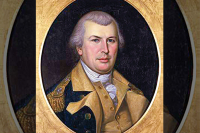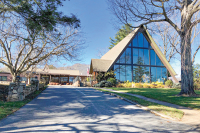Cherokee cuts the ribbon on $26 million justice center, tribe’s first jail
 It’s not every day that the scent of barbecue meatballs wafts through the open doors of a jail filled with smiling people wearing slacks, sport coats and blouses. But it’s also not every day that a sovereign nation finishes building its first-ever justice facility.
It’s not every day that the scent of barbecue meatballs wafts through the open doors of a jail filled with smiling people wearing slacks, sport coats and blouses. But it’s also not every day that a sovereign nation finishes building its first-ever justice facility.
“This is not just about a building,” said Principle Chief Michell Hicks as he prepared to cut the ribbon on the $26-million building in a ceremony that had nearly all of the building’s 175 parking spaces full. “It’s not just about having a place to put our stuff. We’re going to change who we are as a people.”
Plans for the jail
Cherokee has never had its own jail before, instead sending inmates to other counties to await sentencing and to any of a variety of detention centers afterward. The tribe pays Swain County, which houses a large share of the inmates, $40 per inmate per night, with Cherokee inmates making up about 20 to 30 of the 80 to 100 inmates the Swain jail typically holds, Swain County Sheriff Curtis Cochran said.
That situation had a few different drawbacks for Cherokee. Getting an inmate from the jail to the Cherokee courtroom takes a lot of time and man-hours, and all of that transportation has made the process less secure than it will be now. In addition to a 96-bed jail, the justice center will house the police department and the court system, meaning inmates won’t have to leave the building to move from one to the other.
But most importantly, said Cherokee Police Chief Ben Reed, the new facility will bring with it increased opportunity for Cherokee to look after its own, providing rehabilitation resources to inmates to reduce the likelihood that they’ll return to a jail cell.
Related Items
“We want it to be a firm, strict jail environment, but we also want to reach out to the resources we can,” Reed said. “We want to give folks what they need to come out of jail and be productive.”
Inmates will be given access to resources to cope with mental health, substance abuse and physical abuse issues. Reed would like the jail to offer religious services and high school equivalency classes and to eventually incorporate work programs teaching job skills into the offerings.
But, he emphasized, the jail regimen won’t be “playtime.” The tribe will hire 24 detention officers and a jail administrator to maintain a strict atmosphere.
“There’s not going to be much idle time. We want to keep them busy,” Reed said. “We don’t want them to like it and want to come back.”
A boon for the justice system
The ribbon-cutting ceremony featured speakers including Tribal Council Chairwoman Terri Henry, Cherokee Supreme Court Chief Justice Bill Boyum, Vice Chief Larry Blythe, Director of Planning and Development Jason Lambert and Project Manager Damon Lambert, in addition to Hicks and Reed. Nearly all of them spoke of their hope for a better form of justice in Cherokee, one that provides consequences for crime while also helping inmates turn their lives in a more positive direction before leaving.
“This is a very important day for us,” Henry said.
Important because of the opportunities offered by the jail, but also because of the union of the tribe’s law enforcement and criminal justice systems under one roof. The second story of the 76,000-square-foot building is mainly jail facilities, while the first floor is split between the police department and the court system.
Boyum is looking forward to moving in under the same roof as the police and jail. The Cherokee court has found a lot of unlikely homes over the years — the living room of a home, an “old, moldy building,” an unused classroom, and most recently the old civic center on Acquoni Road where Boyum used to play basketball — so Boyum is glad to finally be able to hold court in a building built for that purpose.
Because the new facility is nicer, sure, but also because it’s more secure. The new justice center features separate entrances and passages for attorneys, inmates and the public as well as cells just outside the courtroom where inmates can be held safely until the court is ready for them. That makes it much more secure than the situation now, and the new setup will come with a time advantage, too.
“It goes back to the security aspect and the economy of time,” Boyum said. “If we needed to get somebody from Swain County, we’d have to call two hours ahead of time. Here it’s probably 15 minutes as opposed to a couple of hours.”
Besides the more limited functions of the tribal court, though, Boyum is also hoping to provide other services inside the new facility.
For one, he said, Federal Magistrate Judge Dennis Howell will begin coming to Cherokee three to five times each year, starting in April, to rule on routine items like traffic tickets that occur on federal land, such as the Blue Ridge Parkway. Right now, getting that kind of ticket lands a mandatory court appearance in Asheville, a long ways from Cherokee. This is likely the first time federal magistrate court has been held on an Indian reservation, Boyum said.
Cherokee courts are also in talks about bringing a federal probation officer to Cherokee, and over the long term, Boyum would like to see a full-blown district court in Cherokee. That would make things a lot more convenient, because tribal court can handle only crimes that carry penalties of three years or less with a maximum cumulative sentence of nine years. Crimes that warrant more prison time and crimes committed by non-Indians against Indians on tribal land must be tried in federal court, if at all. Crimes committed between non-Indians on tribal land go to state court.
“We’re in discussions with them about having some regular district court here,” Boyum said, adding, “Whether that happens or not I don’t know for sure.”
A challenging project
Getting this far with the project hasn’t been easy.
The $26 million building was paid for largely through a grant from the 2009 American Recovery and Reinvestment Act, with funding provided by a U.S. Department of Justice program to construct and renovate correctional facilities on tribal lands. The tribe’s $18 million grant, the third largest given nationwide, required a $2 million match to unlock. About one year into the construction phase, tribal council was informed that the project was going over budget and would require an additional $6 million to complete.
The extra funds were needed because the scope of the project had changed from building just a jail to housing a new courthouse and police station as well, Deputy Finance Director Kim Peone told council at the time.
It was a challenging project to figure out, Lambert said, because of all of the security and legal aspects that are unique to jails and courthouses. Surveillance technology, fire prevention and the separate passageways required to keep inmates, legal personnel and the public separate all require special consideration. One of the hardest parts to design, he said, was a drive-in evidence garage to allow officers to examine large pieces of evidence — like a car, couch or bed — in a protected area.
“That’s something they really wanted,” Lambert said. “It was really hard to figure out the design of it.”
But figure it out they did, along with a myriad of other puzzles and conundrums along the way. The result, Chairwoman Henry said, is a building that everyone in the tribe can be proud of.
“It’s my honor to work with the tribal council, to work with the chiefs and put all our hands under this to lift it to where it is today,” she said at the ribbon cutting.









